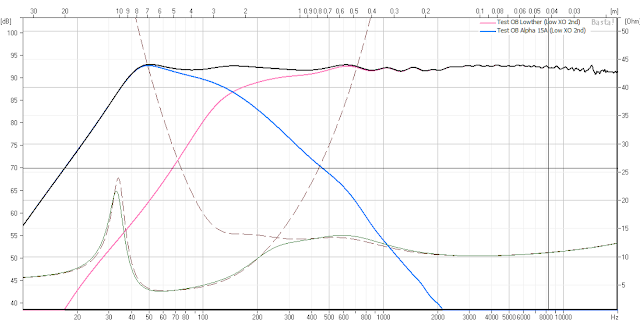Did some more modelling, and started to apply a BSC to the design. From playing around, it seems that 2nd order passive cross over is going to be the easiest start, though I am playing with using the same components as that of a 1st order, so that I can add the parts to make it into a second order crossover. I have also played with turning room gain on and off. In either scenarios, the outcome is fairly similar, save the level of attenuation for the Lowther.
In both scenarios, I am using a 450mm wide and 1,000mm tall baffle, where the centre of the Lowther 800mm from the floor and 140mm from one edge. The BSC applied for this is with 3R 68uF and 1.5mH, all in parallel.
I have tweaked the passive cross over so that the values are now using 68uF and 8mH. The assumed resistance of the coil is 2.7R and the L-pad is 2R. The active crossover is 260 Hz for the Lowther and 150Hz for the Alpha. The charts are below. Both have the same speaker layout, room gain, etc.
 |
| Active crossover option. |
 |
| Passive crossover option. |
Part of this, I also wanted to see what would happen if I upgraded to a PM2a or PM5a, and they all perform very similarly in the modelling. I am certain that there will be small tweaks that can be done to optimize each driver, but the basic parameters are very similar.
Right now, the question is whether I should building the passive version, or finish building the
Boozhoundlab crossover. I am thinking that the costs for the two are similar. Though I am thinking that the number of caps for the active is quite large (14 nos. in total), and the cost may be relatively high if one chooses the boutique caps. Also, long term, it will probably be easier to upgrade the passive components as part size is not a huge issue. Plus, I already have 1.5 mH inductors for the Beyma handy...
Parts for the Passive 2nd order:
68uF Capacitor x4 (Lowther BSC and XO)
220uF Capacitor x2 (Alpha XO)
1.5mH Inductor x2 (Lowther BSC)
8mH Inductor x4 (Lowther and Alpha XO)
2R Resistor x2 (Lowther L-Pad, though I will likely use the Fostex R80B that I have)
Parts of the Active 2nd order: (Excluding the PS and the JFETS)
0.1uF Capacitor x8 (Input and HP output coupling and XO)
0.033uF Capacitor x4 (XO)
10uF Capacitor x2 (LP Output)
Whole range of resistors and PS caps
















